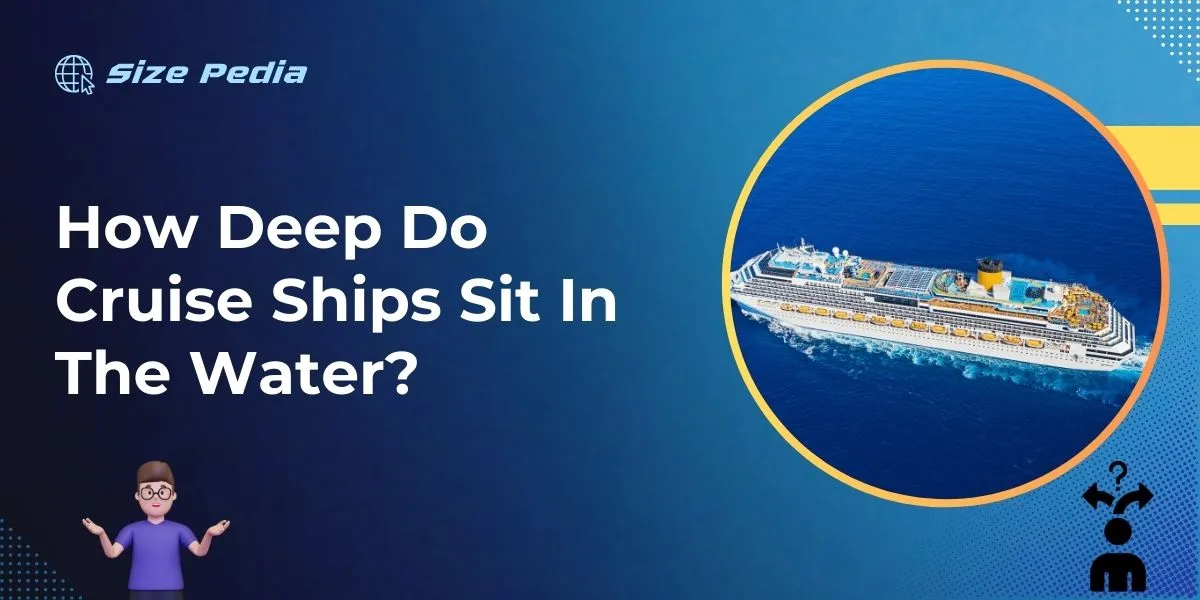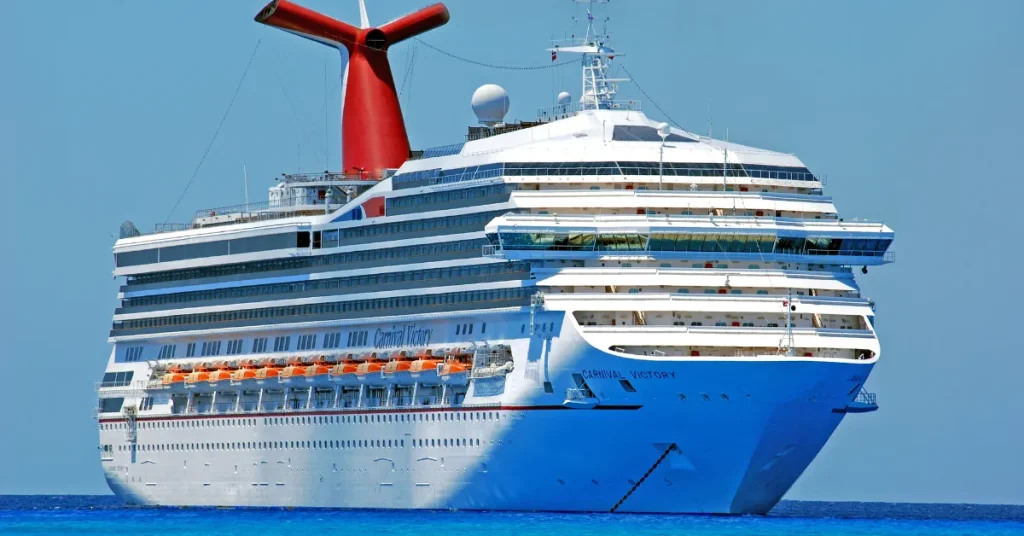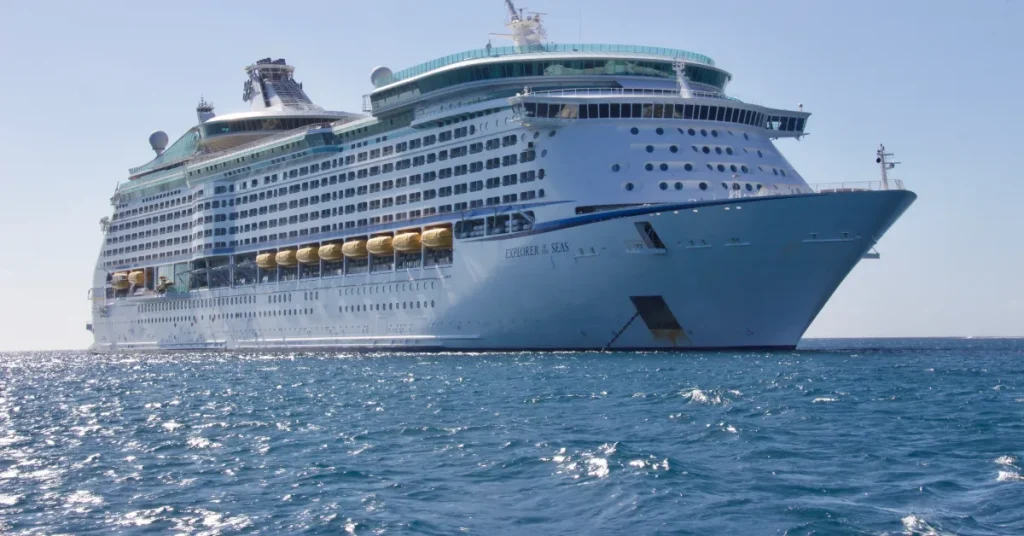Cruise ships have an average draft of 25 to 30 feet, meaning they sit 25 to 30 feet below the waterline. The depth can vary based on the ship’s size and design.
Cruise ships are engineering marvels, designed to balance size, stability, and sea-worthiness as they navigate various marine environments. The draft of a cruise ship, the distance between the waterline and the bottom of the hull, is a critical factor in its design.
It affects everything from the ship’s ability to enter certain ports to its stability in open water. Knowledge of a cruise ship’s draft is essential for maritime navigation and safety.
Whether you’re a cruise enthusiast or a maritime professional, understanding this aspect of nautical engineering offers deeper insight into how these floating resorts operate and adapt to the diverse conditions they encounter at sea.

The Science Of Buoyancy And Cruise Ships
The Science of Buoyancy and Cruise Ships is a fascinating topic. It explains how massive vessels float. You might think huge cruise ships would sink. But science keeps them afloat. Let’s explore this further.
Archimedes Principle At Work
Archimedes Principle is key to understanding this. It states that any object in a fluid gets an upward force. This force equals the weight of the fluid displaced by the object.
- A cruise ship displaces water when it sinks into the sea.
- The water pushes back, creating buoyancy.
This principle ensures the ship does not sink if designed right.
Density And Displacement Factors
Density and displacement affect how a ship sits in water.
| Density (kg/m³) | Displacement (ton) |
| Sea Water | Ship’s Weight |
| Cruise Ship Material | Volume of Water Displaced |
A cruise ship floats because its overall density is less than water.
- Design distributes the ship’s weight.
- Ensures not too heavy for the displaced water.
Analyzing Cruise Ship Design
Delving into the fascinating realm of cruise ship design unveils the intricate balance of engineering and artistry that determines how deep these majestic vessels sit in the water.
The depth, known as the draft, is pivotal for the ship’s functionality and passenger safety. Today we’ll dissect two vital aspects of design that influence a cruise ship’s draft: the Hull Form and Function and the Weight Distribution Strategies.
Hull Form And Function
The hull’s shape and size are key to a ship’s buoyancy and stability. Cruise ships boast a wide and deep hull. This design supports the heavy weight of the ship and its contents. Let’s explore the hull’s roles:
- Supports the vessel: Helps bear the weight of the cruise ship.
- Aids in stability: Counters waves and wind for a smooth journey.
- Reduces drag: A sleek hull cuts through water, saving fuel.
Weight Distribution Strategies
A well-planned weight distribution is crucial for safety and comfort on board. Engineers use advanced methods to spread the ship’s weight. This ensures the ship stays upright and moves efficiently through the water. Some strategies include:
- Ballast systems: Adjusts water in tanks to balance the ship.
- Low center of gravity: Heavy items are placed low in the ship.
- Even loading: Ensuring cargo is spread out evenly.
By carefully designing the hull and strategically distributing weight, cruise ships maintain the ideal draft. This allows them to traverse various water depths safely while providing a comfortable experience for passengers.
Depth Measures: Draft And Freeboard

Cruise ships are giants of the sea, but just how deep they sit in the water is a question of draft and freeboard.
Draft refers to the distance between the waterline and the bottom of the hull. Freeboard is the distance from the waterline to the top of the deck. Together, they determine a ship’s seaworthiness and cargo capacity.
Calculating The Draft Of A Vessel
Understanding a ship’s draft is crucial for safe navigation. Draft calculation involves depth markers on the hull. These markers show how deep the ship sits. They ensure the vessel doesn’t run aground.
Let’s break down draft calculation:
- Find the waterline.
- Locate the draft markings.
- Measure the distance from the markings to the waterline.
- Combine bow and stern measurements for the average draft.
Understanding Freeboard
The freeboard keeps a ship afloat and stable. High freeboard means more ship above water. This is good for rough seas. Low freeboard can be risky. So, how is freeboard measured?
- Start at the waterline.
- Measure up to the top of the deck at the side of the ship.
- Note the distance—that’s the freeboard.
Cruise ships have calculated drafts and freeboards for safety. This data guides load limits and routes, ensuring passengers enjoy their sea journey without worry.
Environmental Impact On Sailing Depths
Understanding how deep cruise ships sit in water is crucial. Depth affects navigation and environmental well-being. This article explores the environmental impact on sailing depths.
Effects Of Saltwater Versus Freshwater
Cruise ships displace water, creating buoyant force. This varies with water type.
- Saltwater’s higher density helps ships float higher.
- In freshwater, ships sit deeper due to lower density.
Differences in buoyancy affect marine ecosystems. Ships must account for these changes to prevent groundings and protect aquatic habitats.
Weather Conditions And Water Depth
Weather conditions directly impact water levels. Strong winds and precipitation patterns can alter depths, posing challenges for cruise ships.
Let’s break down the elements:
| Condition | Impact on Depth |
| High winds | Sea level rises, increasing depth. |
| Heavy rainfall | Freshwater influx reduces salinity, causing ships to sit lower. |
| Droughts | Decreased river inflows lower water levels, reducing depth. |
Cruise ships must navigate these changes to maintain safety and minimize ecological footprints.
Cruise Ships By The Numbers
Understanding how deep cruise ships sit in the water, known as their draft, is crucial for safe navigation. This measurement tells us how much of the ship is underwater.
Draft affects where a ship can go and is influenced by its size and weight. Let’s dive into the fascinating world of cruise ships and explore their colossal dimensions.
Largest Ships And Their Drafts
The giants of the sea, cruise ships are marvels of modern engineering. Their drafts play a vital role in their design and operation.
| Ship Name | Length | Width | Draft | Passenger Capacity |
| Symphony of the Seas | 1,184 feet | 215 feet | 30 feet | 6,680 |
| Harmony of the Seas | 1,188 feet | 215.5 feet | 29 feet | 6,687 |
| Allure of the Seas | 1,187 feet | 215 feet | 30 feet | 6,780 |
| Oasis of the Seas | 1,186 feet | 215 feet | 30 feet | 6,780 |
The larger the ship, the deeper the draft. It’s fascinating how these floating cities manage to safely navigate through various sea depths.
Comparison With Other Watercraft
Cruise ships have deeper drafts compared to many other vessels. Here’s a quick comparison:
- Sailboats: range from 2 to 12 feet, depending on size and design.
- Fishing boats: small ones can have drafts as little as 1 foot, larger commercial vessels may go up to 15 feet.
- Container ships: can range anywhere from 16 to over 50 feet.
- Aircraft carriers: typically around 37 feet.
Cruise ships often sit lower in the water than many boats but not as deep as the largest cargo ships. Their draft is a delicate balance to ensure they can visit a wide range of ports around the world.
Navigational Challenges And Solutions

Imagine a floating city, a cruise ship that’s a marvel of engineering. Yet, its grandeur poses unique challenges when cruising along the watery globe.
The depth at which these behemoths sit in the water, often termed ‘draft’, influences where they can sail. Let’s unearth the barriers they face and the ingenuity applied to stay afloat in the safest way.
Dealing With Shallow Waters
Cruise ships need deep waters to prevent touching the bottom. But not all ports or passages are deep enough. Problems arise from shallow spots known as underwater high points. These spots can scratch or even puncture a ship’s belly.
To combat this, cruise ships have specific paths marked on maps. These paths are like roads in the sea. They are called shipping lanes. Ships follow these paths to stay safe.
Some areas use pilots. Pilots are experts in local waterways. They come onboard to guide the ship. They know where the deep and shallow parts are. This helps the ship avoid accidents.
When the water is too shallow, some ships will lighten their load. This makes them sit higher in the water. Another trick is to sail during high tide, when the sea level rises.
Technological Aids For Safe Passage
Cruise ships use high-tech tools to dodge danger. One tool is a sonar system. This system sends out sound waves. The waves hit the bottom and bounce back. The ship knows how deep the water is from this.
There is also something called GPS, which stands for Global Positioning System. This tells the ship exactly where it is on the world map. It uses satellites in space to do this. A ship’s digital maps work with GPS. They show safe routes through tricky waters.
Another helper is the Doppler radar. This radar looks at the water under the ship. It can tell how fast the ship moves and if anything is in the way.
Ships also have ballast systems. Think of them like water balloons inside the ship. When filled, they help keep the ship stable. They can also adjust the ship’s draft for different water depths.
FAQs About How Deep Do Cruise Ships Sit In The Water
What Is The Draft Of A Cruise Ship?
The draft of a cruise ship refers to the distance between the waterline and the lowest part of the hull (keel). Typically, cruise ships have a draft ranging from 25 feet (7. 6 meters) to 30 feet (9. 1 meters), depending on the vessel’s size and design.
How Much Water Depth Is Needed For A Cruise Ship?
A cruise ship requires water depth that is at least two to three times greater than its draft. This means depths of approximately 60 to 100 feet (18. 3 to 30. 5 meters) are necessary to ensure safe passage and maneuvering, especially in port areas.
Does Ship Size Affect Water Displacement?
Yes, ship size directly affects water displacement. Larger ships displace more water due to their greater draft and overall dimensions, which increases the volume of water a ship pushes aside to stay afloat. Thus, the bigger the ship, the more water it displaces.
Can Cruise Ships Navigate Shallow Waters?
Cruise ships are generally designed for deep waters and may struggle in shallow waters. However, some smaller cruise ships and those specifically designed for river cruising can navigate in shallower waters, with drafts often less than 10 feet (3 meters).
Conclusion
Understanding the depth at which cruise ships rest in water is key for maritime safety and efficiency. This knowledge ensures the seamless journey of these floating resorts. Remember, factors like ship design and load weight dictate a cruise ship’s draft.
So next time you’re aboard, you’ll appreciate the engineering marvel beneath your feet, designed to navigate the ocean’s depths.
Resources:
1. https://wwwnc.cdc.gov/travel/yellowbook/2020/travel-by-air-land-sea/cruise-ship-travel
